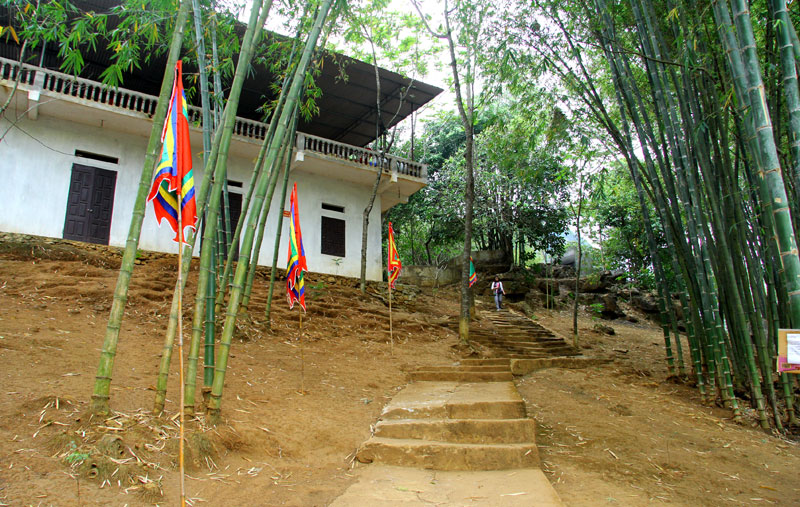
(HBO) – The Temple of Mieng Cave is a famous attraction of spiritual tourism in the area around Hoa Binh Lake. It is located in Quang Minh commune of Van Ho district, Son La province. Tourists can reach the temple by both waterway and road. Those who come to the temple by boat can depart from Bich Ha Port or Thung Nai Port which are 70km and 50km away respectively. The temple is a solemn place of worship and believed to be very sacred by local people.

The
Temple of
Mieng Cavein Quang Minh commune of Van Ho district, Son La province
Mieng
Cave is an old karst cave which was previously a stopover of
traders from lowland regions and fishermen. Residents built a temple there in
commemoration of Dinh Thi Van, a heroine from the Muong ethnic minority group,
who encouraged local people to donate food. She, together with other people,
navigated boats along the Da River to carry food to the army of King Le Loi.
After a number of successful food delivery trips, one time, her boat full of
food encountered a storm and sank in a river section near
Mieng
Cave.
Her body was drifted to the area of Thac Bo (Bo Waterfall). To show respect for
and commemorate her merit, local people built a temple dedicated to her at
Mieng
Cave.
It is also called the temple of the Lord of Mieng Cave.
In the early 20th century, the French
colonialists expanded the temple. A temple of the Lord of Bo Waterfall in Vay
Nua commune of Hoa Binh province was also set up to wish for her protection of
trips along the Da River. When the Hoa Binh hydropower plant was constructed,
this temple was flooded and then moved to
Dau
Rong
Mountain.
The Temple of Mieng Cave is believed to be very
sacred. Once coming to the temple, visitors can enjoy the picturesque beauty of
Hoa
Binh
Lakeand tranquil moments while learning more about legends of Dinh Thi Van. Prayers
for peace, wealth and children said at the Temple of Mieng Cave are also
believed to come true. In the past, visitors to the temple were mainly people
residing along the Da River in Hoa Binh and Son La provinces. At present, the
temple is a must-visit destination for all who tour the Da River.
The area of
Mieng
Cavealso has a flea market opened on the 1st, 2nd, 11th, 12th, 21st and 22nd of
every month. A number of ethnic people from communes bordering
Hoa
Binh
Lake come to the market
on these days. The market features all types of products, from vegetables, fish
to essential goods serving the daily life and production activities, creating
worth-to-explore identities for visitors to the Temple of Mieng Cave./.
A diverse chain of eco-tourism and resort destinations concentrated in Hoa Binh city and the districts of Tan Lac, Da Bac, and Luong Son… Along with the launch of several key high-quality resort tourism projects, these developments have reshaped the landscape and enhanced the appeal of Hoa Binh as a travel destination.
Boasting diverse terrain, a mild climate, and rich natural resources, Cao Phong district is increasingly asserting its place on Vietnam’s tourism map, attracting both domestic and foreign visitors. The district is renowned for its stunning landscapes, majestic mountains, a crystal-clear hydropower lake, and the unique cultural identity of local ethnic groups.
With its pristine landscapes, unique cultural heritage of Muong ethnic minority, and an expanding range of visitor experiences, Tan Lac district of Hoa Binh has fast become a captivating destination for both domestic and international tourists.
Until now, Sung village in Cao Son commune, Da Bac district remains the only Dao ethnic community in Hoa Binh province to develop a community-based tourism model. Beyond its untouched natural landscapes, cultural identity serves as the cornerstone attraction for visitors.
Alongside the diverse cultural identities of the Kinh, Muong, Tay, Thai, Dao, and Mong ethnic people, Hoa Binh province is also renowned as the "capital" of the northwestern Vietnamese cuisine, offering unique and distinctive dishes. At festivals, during Lunar New Year (Tet), or on significant family or community occasions, special dishes are prepared, leaving a lasting impression on visitors.
A Phong Linh (Yellow Tabebuia) flower garden in Thang village, Thach Yen commune, Cao Phong district is currently in full bloom, drawing a large number of visitors.



